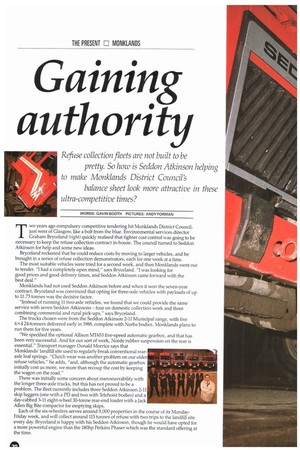Gaining authority
Page 132

If you've noticed an error in this article please click here to report it so we can fix it.
Refuse collection fleets are not built to be pretty. So how is Seddon Atkinson helping to make Monklands District Council's balance sheet look more attractive in these ultra-competitive times?
WORDS: GAVIN BOOTH PICTURES: ANDY FORMAN
Two years ago compulsory competitive tendering hit Monklands District Council, just west of Glasgow, like a bolt from the blue. Environmental services director Graham Bryceland (right) quickly realised that tighter cost control was going to be necessary to keep the refuse collection contract in-house. The council turned to Seddon Atkinson for help and some new ideas.
Bryceland reckoned that he could reduce costs by moving to larger vehides, and he brought in a series of refuse collection demonstrators, each for one week at a time.
The most suitable vehicles were tried for a second week, and then Monklands went out to tender. "I had a completely open mind," says Bryceland. "I was looking for good prices and good delivery times, and Seddon Atkinson came forward with the best deal."
Monklands had not used Seddon Atkinson before and when it won the seven-year contract, Bryceland was convinced that opting for three-axle vehicles with payloads of up to 11.73 tonnes was the decisive factor.
"Instead of running 11 two-axle vehicles, we found that we could provide the same service with seven Seddon Atkinsons — four on domestic collection work and three combining commercial and rural pick-ups," says Bryceland.
The trucks chosen were from the Seddon Atkinson 2-11 Municipal range, with five 6x4 24-tonners delivered early in 1988, complete with Norba bodies. Monklands plans to run them for five years.
"We specified the optional Allison MT653 five-speed automatic gearbox, and that has been very successful. And for our sort of work, Norde rubber suspension on the rear is essential." Transport manager Donald Morrice says that Monklands' landfill site used to regularly break conventional rearaxle leaf springs. "Clutch wear was another problem on our older refuse vehicles," he adds, "and, although the automatic gearbox initially cost us more, we more than recoup the cost by keeping the wagon on the road."
There was initially some concern about manoeuvrability with the longer three-axle trucks, but this has not proved to be a problem. The fleet currently includes three Seddon Atkinson 2-11 skip luggers (one with a PD and two with Telehoist bodies) and a day-cabbed 3-11 eight-wheel 30-tonne rear-end loader with a Jack Allen Big Bite compactor for emptying skips.
Each of the six-wheelers serves around 9,000 properties in the course of its MondayFriday week, and will collect around 115 tonnes of refuse with two trips to the landfill site every day. Bryceland is happy with his Seddon Atkinson, though he would have opted for a more powerful engine than the 180hp Perkins Phaser which was the standard offering at the time.
























































































































































